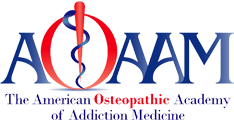American Osteopathic Association's Annual Osteopathic Medical Conference and Exposition (OMED) is the premier educational event for the osteopathic medical profession.
 OMED25 - Osteopathic Medical Education Conference
AOAAM’s OMED 2025 AgendaThursday, 9/25/2025, at 11:00 AM - 12:00 PM – Infectious Complications of Substance Use: Endemic Epidemics and Syndemics Hunter Spencer, DO - 1 CME Thursday, 9/25/2025, at 12:00 PM - 1:00 PM – Buprenorphine 20 Years After Approval - The Efficacy and Safety Stephen Wyatt, DO - 1 CME Thursday, 9/25/2025, at 1:00 PM - 2:00 PM – MATTERS: A Bold New Model Revolutionizing Harm Reduction and Treatment Access for SUD Joshua Lynch, DO - 1 CME Thursday, 9/25/2025, at 2:00 PM - 3:00 PM – A Day in the Life Jan Widerman, DO - 1 CME Thursday, 9/25/2025, at 3:00 PM - 4:00 PM – Artificial Intelligence (AI) and Addiction Medicine - Promises and Perils R. Gregory Lande, DO & Amy Miles, DO - 1 CME Thursday, 9/25/2025, at 4:00 PM - 5:00 PM – Substance Use Disorders in the Neurodiverse Population Anthony Dekker, DO - 1 CME Friday, 9/26/2025, at 10:00 AM - 11:00 AM – Bridging the Science of SUD/MH - Neurocognitive Assessment and Neurorestorative Care Barbara Krantz, DO - 1 CME Friday, 9/26/2025, at 11:00 AM - 12:00 PM – A Comprehensive Approach to Behavioral Assessments Jason Kirby, DO - 1 CME Friday, 9/26/2025, at 1:30 PM - 2:30 PM – Treatment of Healthcare Professionals, "Healing the Healers" Michael McCormick, DO - 1 CME Friday, 9/26/2025, at 2:30 PM - 3:30 PM – From Depression to Dementia: The ever expanding applications of Transcranial Magnetic Stimulation (TMS) Antonello Bonci, MD - 1 CME Friday, 9/26/2025, at 3:30 PM - 4:30 PM – Use of GLP-1 RA in Treatment of SUD Steven Klein, MD, PhD - 1 CME Saturday, 9/27/2025, at 9:00 AM - 10:00 AM – Addressing Hepatic Co-Morbidity in Concert with SUD Treatment Ray Bobb, DO - 1 CME Saturday, 9/27/2025, at 10:00 AM - 11:00 AM – Substance Use Disorder Treatment in the LGBTQ+ Population: Building Affirming and Effective Care Models Steven Klein, MD, PhD - 1 CME Saturday, 9/27/2025, at 11:00 AM - 12:00 PM – Overview and Treatment of Substance Use Disorders in the OB population Juan Franco, DO - 1 CME Saturday, 9/27/2025, at 12:00 PM - 12:30 PM – AOAAM Awards - Remarks form Dr. Mangiacarne to AOAAM members in attendance - 0 CME Saturday, 9/27/2025, at 1:30 PM - 3:00 PM – Doc, Can I Get a Brain Transplant? A Bio-Psycho-Social-Spiritual Overview of Addiction and Cutting-Edge Neuromodulation Research James Berry, DO - 1.5 CME Saturday, 9/27/2025, at 3:00 PM - 4:00 PM – Safe Tables TBA - 1 CME Agenda subject to change. |
